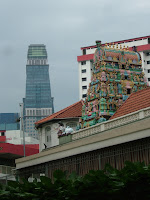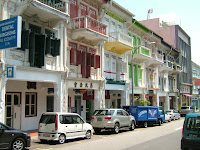"Don’t panic…"
The Hitchhiker’s Guide to the Galaxy is what we would now call a hand-held device, and was invented in the 1970s by Douglas Adams. Well, perhaps “created” is the better word, since this electronic version of the Encyclopedia Britannica gave its title to his off-beat sci-fi comedy saga which eventually found its way from radio on to television and eventually film.
Inspired by the back-packer guides which advise travelers where to stay, how to behave and what to do when things go wrong, the Guide’s most important advice is written on its cover, “in large, friendly letters”. The advice is - Don’t Panic.
Avoiding panic is a good starting point whenever we find ourselves in strange, unexpected situations. Several million international air travelers around the world have had to stay calm recently thanks to the threat of volcanic ash. Pausing to take a deep breath when things go awry is something we probably do, most days. And it’s good advice particularly when trying to communicate in a crisis.
Crises, psychologists tell us, tend to throw people’s normal personality and behaviour traits into reverse. Normally calm, logical people can become hyper-energetic, shoot-from-the-hipsters, while the most creative, talkative members of the team seem to lose the power of speech and remain rooted to their desks, stunned into immobility. Knowing this can happen, a well-prepared crisis plan is a vital tool. It removes the need to try and work out what to do, or what to do first. In that first, disorientating phase of a crisis, a plan makes things easy: do this, go there, speak to these people, say this. Clear instructions help avoid panic, while ensuring the organisation starts to respond rather than leaving a dangerous communication vacuum.
Good crisis response still needs judgment, flexibility and ingenuity, but a plan prepared in advance, coolly and calmly, which everyone understands and has ideally practiced, will reduce the time it takes to start managing a specific incident, and improve the final outcome. This advice applies as much to individuals stuck in a strange environment, far from home, as to corporations suddenly confronted with regulatory investigation or operational breakdown.
Douglas Adams also advised travelers to carry one other item, apart from their electronic guide, when far from home: a towel. He pointed out that you can wrap it around you for warmth, lie on it , sleep under it, wave it in emergencies as a distress signal, even wrap it round your head to ward off noxious fumes, or wet it for use in hand-to-hand-combat. “And of course dry yourself off with it if it still seems to be clean enough.” Not bad advice for people stuck for several days in an airport terminal. Or to put it another way: stuff happens - so always be prepared.
"Would she be amused…?"
What is the connection between last week’s Oscars ceremony, a London suburb, and Britain’s Queen Victoria?
While you ponder this, let me share the most memorable moment of my past week here in Singapore. This is often called the accidental nation – a tiny red dot on the map of the British Empire when it was founded in 1820 by an ambitious employee of the East Indies company – one Stamford Raffles - who could spot a commercial opportunity when he saw it. For Singapore sits at the southernmost tip of the Asian continental land mass. If transporting goods by sea between West and East, ships have to go round this little island. That was true in Raffles’ time, and it is still true now. Which is why, despite being only 3.5 times the size of Washington DC, Singapore is home to one of the world’s largest container ports, has a highly-educated, international population of 4.5 million, and enjoys a per capita GDP amongst the highest in the world.
Singapore’s success is thanks not only to its location, but also to its Government’s never-ending work to attract to its tropical shores international companies in expanding markets. Those efforts mean the country can now boast a growing cluster of digital design companies, including those creating 3-D digital special effects.
And so it was that this week Grayling Singapore found itself promoting a conference on 3-D film techniques. The opening speaker had helped design and create the 3-D world of Oscar-winning “Avatar”. He had plenty to show to impress his audience, but the image which caused the greatest stir was one he showed at the beginning of his talk. Making the point that stereoscopy has a long lineage, he asked the audience to don its red and blue spectacles. Up on the screen came a black and white photo, taken in 1851, of Britain’s sovereign, Queen Victoria. She was opening the marvel of its age - the wood, glass and iron Crystal Palace (now the name of a London suburb), which housed the 1851 Great Exhibition.
And, wonder of wonders, the 159-year old image was in perfect 3D.






